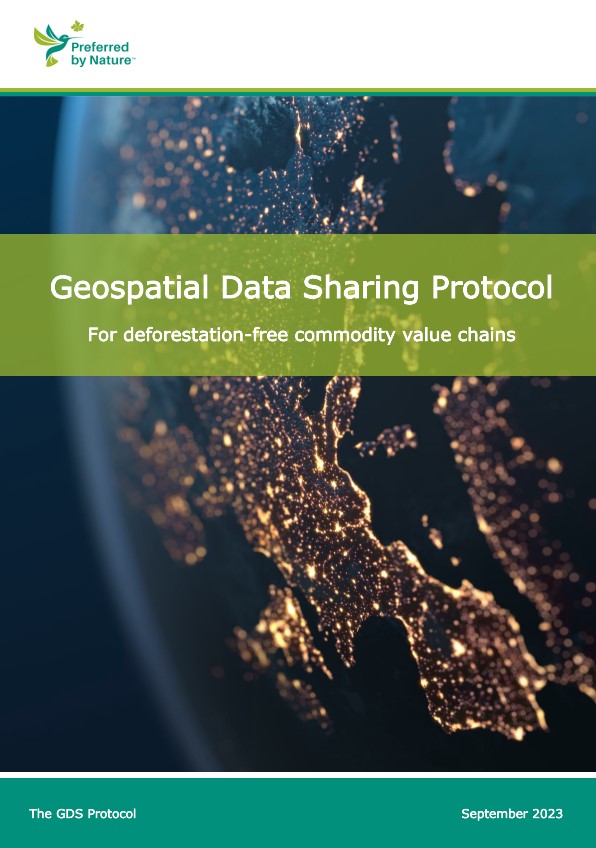The Geospatial Data Sharing Protocol is a pivotal tool for supply ch ains in the age of the EU Deforestation Regulation and growing market transparency requirements.
ains in the age of the EU Deforestation Regulation and growing market transparency requirements.
Discovering the Journey of Your Raw Materials
The story of every product is written by its journey. In today’s world, businesses are not just tracing a product's journey for insightful tales but also to ensure they tread responsibly, meeting the demands of both the market and regulatory bodies. A crucial part of this narrative is geolocation – where the raw material was sourced from. This geospatial data acts as the very backbone for companies aspiring to align with zero-deforestation commitments. Without knowing the origin, it is impossible to conclude if the material has caused deforestation or derived from controversial sources.
The Emergent Need for Geospatial Insight
The recently enforced EU Deforestation Regulation (EUDR) has set a pace for companies to move quickly.
Organisations impacted by the regulation - as well as other stakeholders committed to ensuring their raw materials do not originate from controversial sources - need to trace back to the very locations (points or polygons) of production – whether it is wood, cocoa, coffee, rubber, soy, palm oil, or cattle.
Such precision requires collating geospatial data from multiple harvesting sites, especially since many products pool raw materials from different locations. Thus, the challenge is not just about collecting but effectively managing, sharing, and communicating this data.
Introducing the Geospatial Data Sharing Protocol

Pioneered by Preferred by Nature, and co-created with prominent certification schemes and corporations, the Geospatial Data Sharing Protocol which stands as a digital compass for businesses.
The Protocol provides a systematic set of digital ‘rules’ to transfer and share geospatial points or polygons and other data, ensuring that each transaction of physical goods comes with an attached ‘geospatial envelope’. However, while this protocol illuminates the path for data transfer and sharing, it does not cover the entire terrain. Areas like data validation and full-fledged supply chain traceability remain exploratory territories.
Want to delve deeper? Check out our FAQ here.
Behind the Protocol: The Creation Saga
Conceived between June and September 2023, with the endorsement of the Food and Agriculture Organisation (FAO) under the Forest Data Partnership, this Protocol is a result of collaborative effort. Assisted by experts across forestry and agricultural sectors, the initial draft was shaped by team of tech experts from different certification schemes and international corporations, later opened for wide consultation.
View comments from the September 2023 consultation round.
Special Acknowledgements:
From certification schemes to commercial giants, a plethora of organizations have lent their expertise, making this Protocol robust and relevant. We would like to thank specifically the following organisations with which we’ve had direct interaction, and which have contributed precious input to the first version of the Protocol:
- Certification schemes, international organisations, NGOs and multi-stakeholders initiatives
EFI (European Forest Institute) • EC-JRC (Joint Research Centre of the European Commission) • Fairtrade • FSC (Forest Stewardship Council) • GIZ (Deutsche Gesellschaft für Internationale Zusammenarbeit), leading the DIASCA (Digital Integration of Agricultural Supply Chains Alliance) initiative • ISEAL • Linux Foundation / AgStack • Rainforest Alliance • RSPO (Roundtable on Sustainable Palm Oil) • SBP (Sustainable Biomass Program) • WRI (World Resources Institute)
- Commercial organisations
Chainpoint / Source Intelligence • Enviva • Iba (Indústria Brasileira de Árvores) • IKEA • iov42 • James Griffiths (consultant) • John Simeone (consultant) • LiveEO • Louis Dreyfus Company • Smurfit Kappa (representing CEPI) • Stora Enso
The Protocol in action
The Geospatial Data Sharing Protocol serves as a voluntary standard aimed at enabling a consistent method of sharing geospatial data via data package (“envelopes”). It is designed to simplify the transfer of geospatial information and related data throughout value chains.
Looking Forward
As the protocol finds its roots in the industry, our vision is to continually evolve, refine, and expand its scope. We are committed to ensuring that businesses not only trace their product's journey but also embark on a sustainable path themselves.
FAO and Preferred by Nature are committed to continuing to support the protocol development and are currently looking into field tests, as well as the development of APIs that can support companies handling data according to the protocol and preparing technical guidance.
Get in touch and help us put together a community of interest!
For more information, please contact:
Chloé Viala
Traceability Specialist
E-mail: [email protected]
